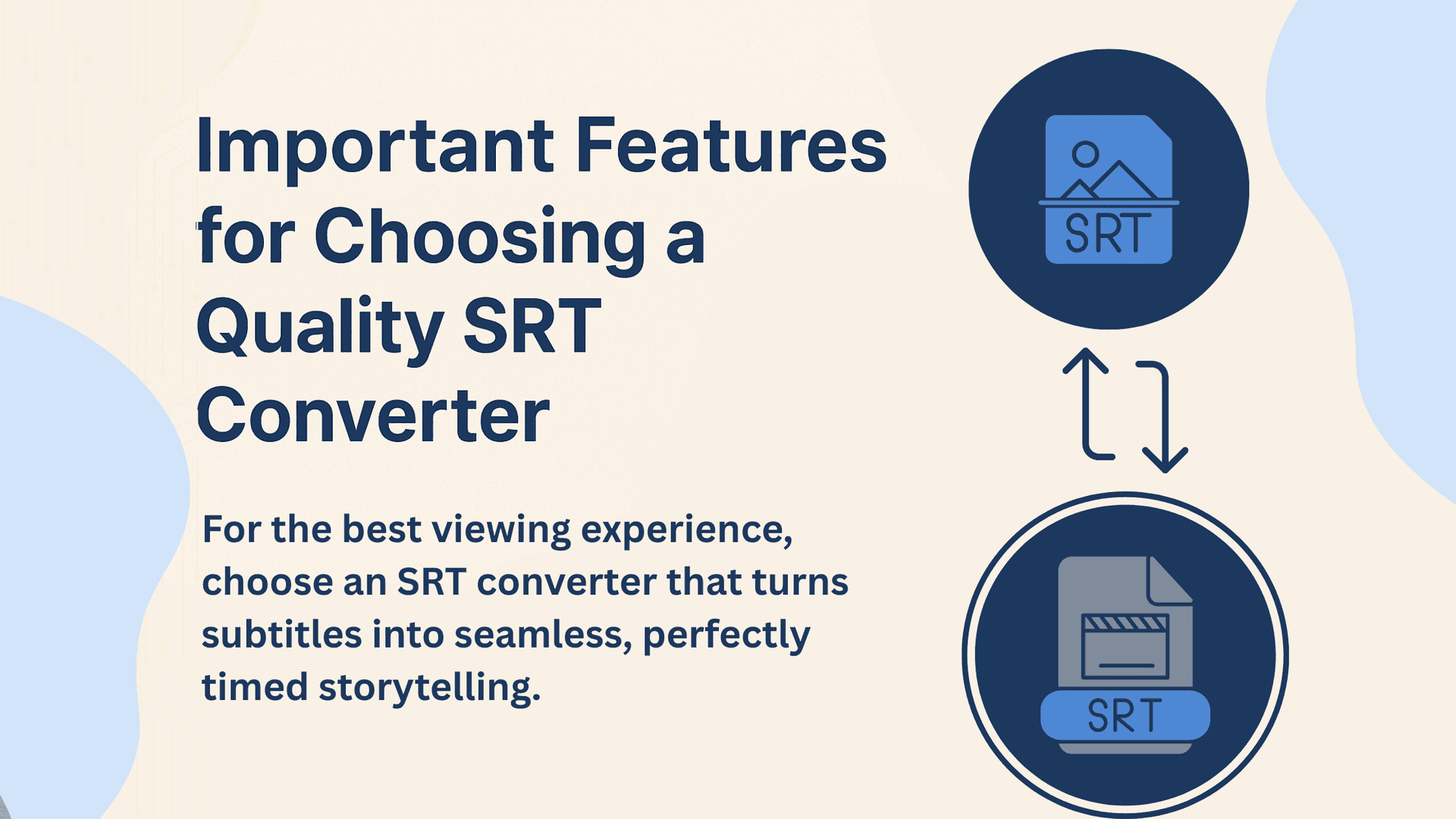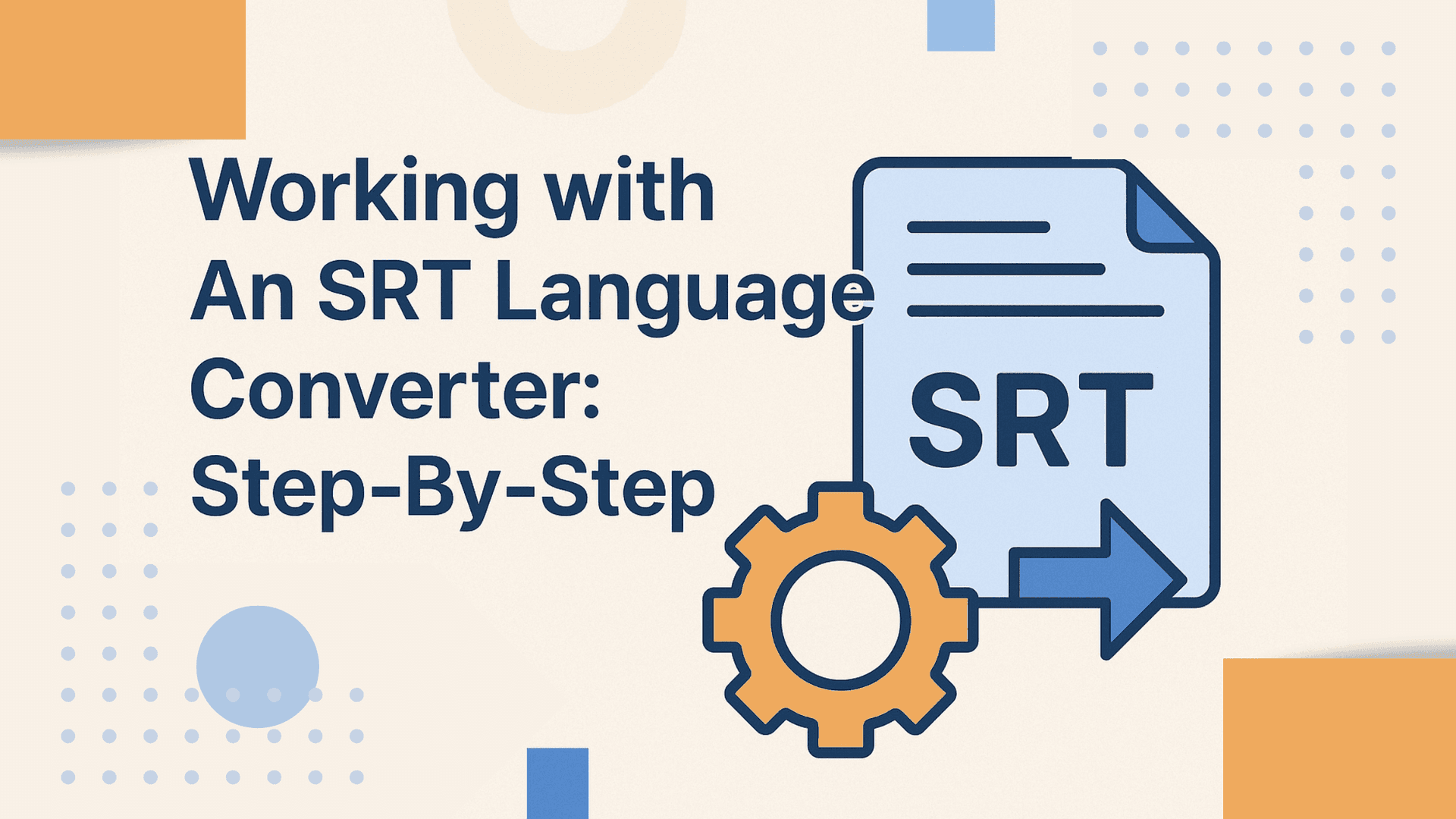SRT Language Converter: Transform Subtitles to Any Language

An SRT converter language tool is pretty much far from being a simple translator. It acts as a bridge between your content and the much larger audience out there enabling the content to be accessed by speakers of other languages or by those with hearing limitations. It allows you to take your original subtitle file and with just a few clicks to convert it into something understood by millions.
This guide will take you through just about everything you need to know concerning SRT language converters, the benefits that really matter and which ones appeal to you and the basic features you do not want to check for and lastly, how to use an SRT language converter and implement it rightly in your global content efforts.
What is SRT actually?
Understanding what you have to deal with an SRT file it is among the most well-known subtitle file formats in presence and is also the simple, most widely supported file format used for closed captions. Here is a plain text file with a dozen entries of timed subtitles.
Each subtitle entry usually has:
A serial number designating the subtitle at hand.
The subtitle’s start and end times are shown in this format:
hours:minutes:seconds,milliseconds.
The very text of the subtitle.
A blank line as an end-of-entry signal.
What makes SRT files so user-friendly and so easy to work with is mainly that they are so light and can be managed easily, while being suitable with almost all major video platforms.
Speaking of the SRT language converter
The main benefit of an SRT language converter is to translate subtitles. Over and above that, it really improves the media through creative means. Here is why an SRT converter is a content creator's best friend.
1. Widening the Reach and Audience:
This is clearly the most basic and therefore, most powerful benefit. Translating your subtitles lets you connect with people who wouldn’t otherwise understand your content. For example, imagine an English documentary now lit up for viewership in Japan, Spain, Germany, and many other countries. That would triple the amount of viewership and guide in a new market and opportunity. For businesses, this means marketing videos can reach new demographics for educators, lessons can be held with students located in various places in the world.
2. Skyrocket SEO to Your Benefit and improves Discoverability:
Google, YouTube and other video tools cannot "watch" your video. The text that accompanies a video holds real searchable value, and subtitles in multiple languages can be a goldmine for SEO. With each translated SRT file, there is a new localized version of your content that search engines can crawl and index. Thus, your videos stand a better chance of being shown in search results for different languages, greatly increasing their chance to get discovered. This gets a powerful kick when you convert SRT language files for very niche content, so helping you controls search results in those areas.
3. Further Accessibility:
There is a good chance that a most of your potential audience is deaf and hard-of-hearing. By providing accurate, faultless subtitles, you allow them access to your content securing your message is not lost. SRT language file conversion goes one further and lets you provide presently needed availability tools in the users own tongue which is central to the creation of complete content for all.
4. Viewer Engagement and keeping improved:
Especially able to hold viewers until the end are videos that can be fully understood. One situation could be in public spaces and workplaces where sound is unavailable. Translated subtitles allow users to read along without audio increasing engagement rates and watch duration. Higher engagement leads to better performance of a video on platforms such as YouTube, where watch time is paramount.
5. Cost and Labor-Saving:
The other option is the employment of a translation expert for all languages you would like to support. This can be time-consuming and costly. An SRT language converter provides a solution that is fast and economical in translating subtitles, so able to localize content on a larger scale. This leaves your resources free to work on what you do best-create great content.
Important Features for the Choosing of a Quality SRT Converter

High-Quality AI-Powered Translation:
The heart of any really good converter is its engine for translation. One should secure that the converter being taken as combines advanced AI and machine learning elements though to provide that kind of accurate context-based translations that most often go beyond simple to the letter exchange. So such idioms, cultural references and technical terms will not cause issues in terms of sounding more natural in translation.
Different conversion:
The more languages your converter supports, the bigger is the audience it can reach out to. A top of the class tool should boast a very complete list of languages, blending together both popular ones and less popular ones. Specifically, it really helps create better targeted content for a creator targeting to enter a much upcoming market where audience use greatly prefers content in their native tongues.
Friendly Interface:
The uploading, translating, and downloading of files must be easy, user-friendly and simple. A clean open platform saves time and reduces the learning path, enabling you to focus on the content instead of trying to collect through complex software.
Batch Processing Capability:
A piece of software should enable you to process many files at a go when you have several videos or an entire season of a show. Batch processing saves time, especially for large-scale projects. Instead of converter SRT language files one at a time you can do bulk conversions.
Internal Editing Tools :
Adjusting is needed even with the best AI results. A good converter should contain a simple editor that allows reviewing and adjusting the translated text, keeping timing matched and editing the small errors. This becomes basic for the above mentioned quality and accuracy of your subtitles.
Format Preservation:
The converter should preserve the original layout that is, line breaks and timing stamps, which secure that all the translated subtitles appear in the right matched with the video, making a smooth experience for the viewer. Without this, one could spend endless hours on manually correcting timing errors.
Integration with Other Services:
Some advanced tools can directly connect with video hosting sites YouTube and Vimeo for example and with video editing software for an even smoother and easy overall workflow, thus clearing the way for simple integration of multilingual subtitles.
Not Just Translation: Best Practices for Perfect Subtitles
The first step is about using an SRT language converter and later a couple more points need to be kept in mind for a truly professional result. Just changing the text is not always the answer when it comes to confirming that an audience will enjoy it. Here are few best practices to really get more out of your translated subtitles:
1. Context is King:
While AI keeps getting better, it can still miss subtle nuances or the intended meaning. Always check the translated subtitles especially for cases that are highly technical heavy with speak and common with culture bound references. A literal translation that does not convey the intended meaning in the other language is not useful therefore, stick to the spirit of the message.
2. Proofread, Proofread, Proofread:
Typos or grammatical errors in a content piece can unskilled it. Even with the best converters the one step proofread in delivering the final output is doubtful. If possible have a original speaker review the subtitles for fluidity and accuracy. This small step could be that big thing that weighs on the scale of how your content is seen.
3. Reading Speed in Mind:
Subtitles should go at a pace where viewers can read comfortably, not hustled. In an ideal situation, a professional subtitle cannot stay on the screen for too short a time, nor can it adjust too many characters per line. While a good SRT language converter might uphold the original timings, some translated phrases may have to be extended or shortened to suit readability.
In this context, having precise timestamps is absolutely essential. Subtitles that are too early or too late become a distraction to the viewer. Therefore, it is important that whichever converter you choose has timestamping down to an art. A tool that enables the user to manually adjust the start or end time of a subtitle line within milliseconds provides the greatest help in achieving the correct matching.
Working with An SRT Language Converter: Step-By-Step

Step 1:
Upload your SRT file First, you have to make sure that your original SRT file is ready. Usually, there is an easy Upload button from which you will select the file from your computer or drag and drop it to the provided area.
Step 2:
Choose Input Language. After upload, a prompt will show you select the language that you want to convert SRT subtitles. Commonly you would either have more than one language selected to work with for batch conversion.
step 3:
You select the language(s), click on "Convert" and "Translate," and get your new subtitles ready. Within a short duration, usually in a matter of minutes, the AI in this tool will analyze your file and create new translated subtitles, provided the given file is fairly short.
Step 4:
Review and Edit (Optional but Recommended) After the translation is done, it is good practice to check the translated texts as well, preferably quickly, for any odd phrasing or contextual errors. If the converter has a fixed editor function you may be able to make these changes directly into the software program.
Step 5:
Download the New SRT File(s) Finally you get to download just created SRT files. The converter usually provides one separate file for each of the translated languages you have chosen. Upload these files to platforms like YouTube, Vimeo, or your own website to make your content accessible worldwide.
Concerning Globalization of Your Content
The SRT language converter is a strong yet simple tool that can enable the creators. Simply put, this technology breaks down language barriers, allowing small creators to connect with a truly global audience. By using this technology and observing a few key best practices you make your content open and available to all while opening up vast opportunities for growth, engagements and success.
Whether you are an independent filmmaker an online educator and a business seeking to expand into international markets an SRT language converter is an invaluable helper that can get all the messages around the globe.